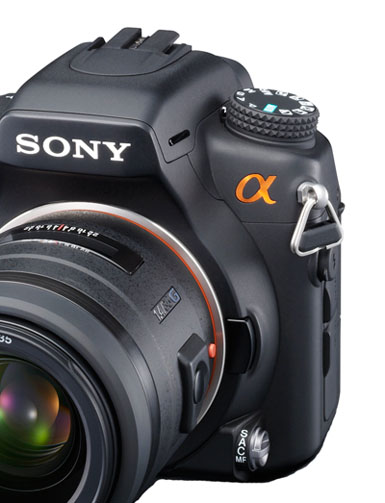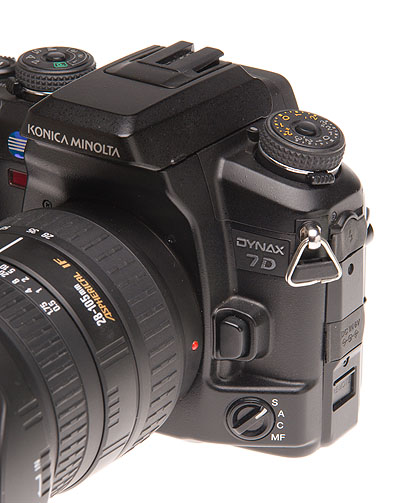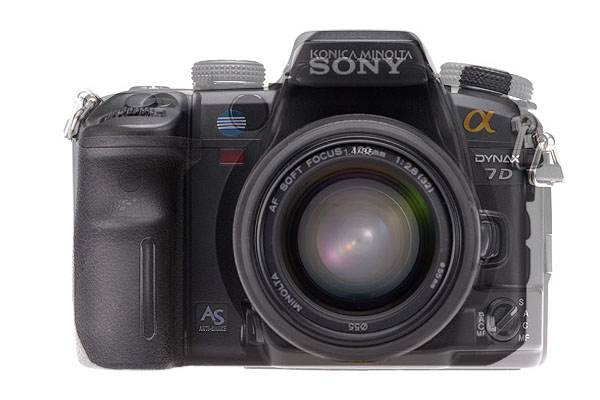How big will the new Alpha be?
NOT AS a force in the market but as a camera body! This question divides the camp of Alpha owners expecting to upgrade to the new Advanced Amateur model (codename A300) when it appears later this year. We now expect the AA model to be on sale before the end of October 2007 in some markets, with a publicity release date some before this.
People who have seen the wooden mock-up – which I have not – are sure that the camera is similar in the size to the Dynax 7D. I think this is an error of visual judgment through a glass case. Sony’s statement, right at the very start when the Alpha 100 was launched, included a commitment to reduce the size and complexity of DSLRs. The new model certainly reduces the number of vulnerable and expensive mechanically linked external controls present in the 7D, using buttons which are more easily sealed against dust and water, and less prone to damage.
But is the size the same?
Here are the two cameras. I have retouched the official image of the ‘A300’ to remove the vertical battery grip, which can influence our impression of size, and taken a view of my Dynax 7D which shows a similar area.
The D-ring for the strap is one component which remains the same size, along with its fitting. The control knob on the new camera is the same size as the A100, not the same as the large factorial over-ride knob of the 7D. Look at the size of the lens mount, which obviously remains constant. On the 7D the prism/mirror box escutcheon has an almost parallel side going down without clipping into the diameter of the lens mount. On the new camera, the mount forces a circular shape to the box.
And look at the space available on the left hand side of the 7D. Even allowing for differences in the size of certain parts (the 7D S-A-C-MF switch is much larger than the new camera’s) there’s an acre of extra camera body real estate on the left hand end of the 7D. Now look at the flash shoe, the size of the prism, and the logo writing.
If this camera truly is the same size as a 7D, then that SONY logo is massive!
I’ve done a rollover which superimposes another packshot of the AA/A300 with a new shot taken head-on of the Dynax 7D. I have fitted a 100mm f/2.8 SF lens because it is more or less the same size as the 35mm f/1.4, but it is obvious from the depth of field and perspective of the Sony packshot (taken on a Phase One digital back) that the camera is even further away. I used a 100mm f/2.8 Macro AF lens for my shot to minimise distortions, and propped the camera up carefully to be directly head-on (coins used for propping up have been retouched out, as has the vertical grip of the AA/A300). Dimensional scaling was done by checking both the lens 55mm thread and the D-ring; the difference was only 1 per cent in 33 (33 versus 34 percent rescale needed from my file to match the packshot) so we can assume the final sizes are within 3 per cent tolerance. Click the link below the composite (Dynax 7D ghosted at 50 per cent opacity over AA) to view the two images in sequence:
In short, I don’t think it is the same size as the Maxxum/Dynax 7D. I think it’s more like the film Maxxum/Dynax 7, which is a much neater overall package, and just a little larger than the Alpha 100. If you place a Dynax 7D and an Alpha 100 together, it is surprising how much of the 7D is on that left hand end and below the lens mount. There is not all that great a difference when measured but visually, and in the hand, the 7D is more substantial.
It is sufficiently so to have made fitting the body into some cases difficult (it’s very tight in the Konica Minolta KMB-1 backpack, but it still fits – the Alpha 100 is easier to get in and out fast) . I’m no fan of large cameras. I was delighted when Olympus introduced the OM-1, and felt totally at home with the Minolta XD-7. Had they not been fairly limited in specification and build quality, I would have liked some of the smaller AF models like the SPxi and Dynax 5 better than the professional offerings.
From the photographs, I believe the A300 is between the A100 and 7D in size and ergonomically much improved over either. The D-rings point to it having an internal magnesium alloy casting or stainless steel monococque shell, unlike the A100 which has strap fittings moulded as part of the outer shell. These D-rings have to be screwed into something solid under the skin, or the skin itself must be structural. They have always been a sign of a certain type of camera construction in Minolta and Konica Minolta days.
In case anyone thinks I am implying it is more LIKE the A100 than the 7D, I am not. The main body height appears to be about the same as the 7D, as does the distance from the lens axis to the baseplate. The contours seem slightly more rounded, the left hand end is shorter (most of the difference seems to be at this side of the camera) and the handgrip is broader. Of course, these photographs do not show the thickness of the camera and that will contribute to its overall feel.
So, we can expect the A300 to be a match for the build quality – the heft – of the 7D. But it will be a little smaller and neater all round, not identical in size, and when it is compared directly and handled the difference will be clear enough.
– David Kilpatrick



